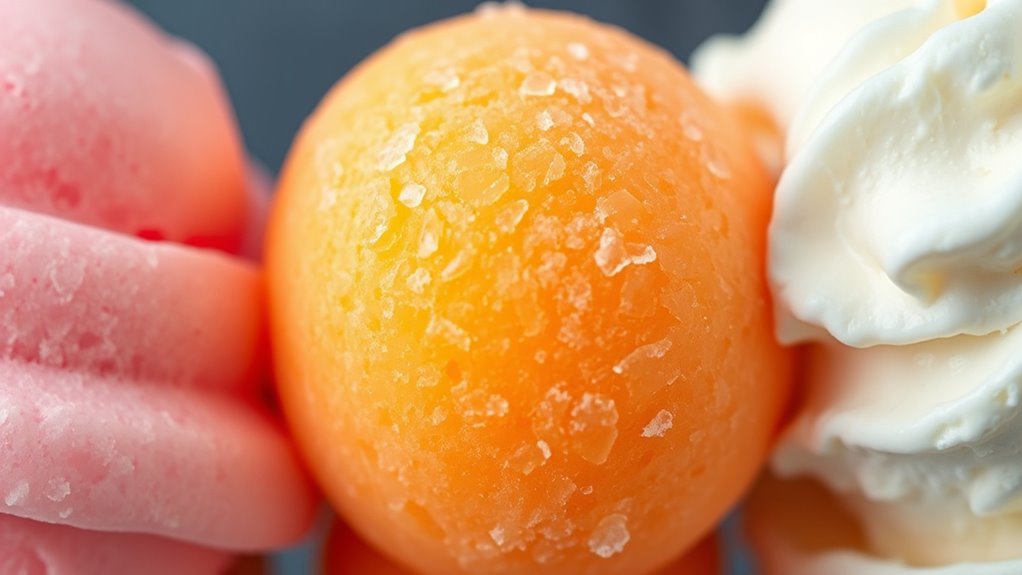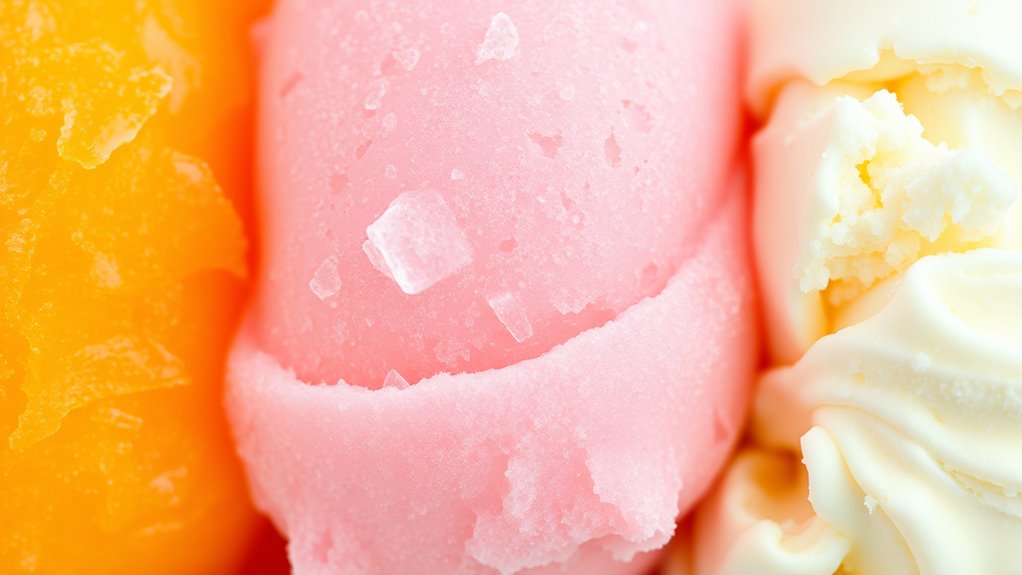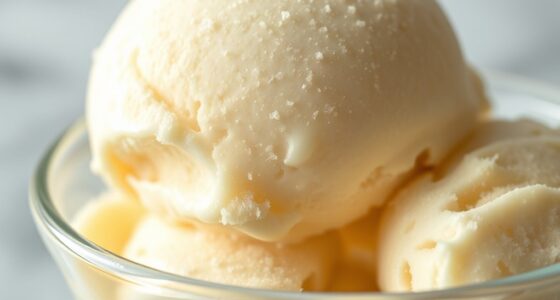If you compare sorbet, sherbet, and ice cream, you’ll notice that ice cream contains at least 10% milkfat and dairy ingredients, giving it a rich, creamy texture. Sherbet has a small amount of dairy (about 1-2%), offering a lighter, fruity flavor with a subtle creaminess. Sorbet has no dairy, relying solely on fruit juice or puree, making it invigorating and vegan-friendly. Exploring these differences helps you choose the perfect treat for any occasion.
Key Takeaways
- Ice cream contains at least 10% milkfat and dairy ingredients, while sherbet has 1-2% milkfat; sorbet contains no dairy.
- Ice cream is rich and creamy due to high dairy content, whereas sherbet is lighter with subtle creaminess, and sorbet is icy and fruit-focused.
- Dairy in ice cream and sherbet enhances flavor depth and texture, unlike sorbet which relies solely on fruit juice or puree.
- Sorbet is dairy-free, vegan-friendly, and lower in fat, while ice cream and sherbet contain varying dairy amounts for richness.
- The ingredient differences influence texture, flavor, dietary suitability, and ideal serving occasions for each frozen treat.

When choosing a frozen treat, understanding the differences between sorbet, sherbet, and ice cream can help you pick the perfect dessert. Each of these treats has unique ingredients that influence their taste, texture, and overall experience. The main distinctions lie in their dairy content and flavor profiles, which directly impact how they taste and feel on your palate. Knowing these differences allows you to select the dessert that best suits your preferences, dietary needs, or occasion.
Starting with ice cream, this classic favorite is characterized by its high dairy content. Typically, ice cream contains at least 10% milkfat, which gives it a rich, creamy texture and smooth mouthfeel. The dairy ingredients—milk, cream, and sometimes butterfat—are the backbone of ice cream’s flavor profile. This richness provides a luxurious, indulgent experience, often with a dense, velvety consistency. Because of its dairy richness, ice cream tends to have a more complex flavor profile, especially when ingredients like vanilla, chocolate, or fruit swirls are added. The dairy not only contributes to the flavor but also enhances the body and richness, making it a satisfying choice for those seeking a decadent dessert.
Ice cream’s high dairy content creates a rich, creamy, and indulgent flavor experience.
In contrast, sherbet strikes a balance between sorbet and ice cream, with a modest amount of dairy. Usually, sherbet contains between 1% and 2% milkfat, which adds a slight creaminess without making it as rich as ice cream. The dairy content in sherbet gives it a subtle smoothness and helps round out the tartness of fruit flavors. Its flavor profiles tend to be fruit-forward, vibrant, and revitalizing, often with citrus, berry, or tropical notes. The small amount of dairy creates a softer, lighter texture compared to ice cream, making sherbet a good choice if you want something that’s creamy yet not overly heavy. While the dairy isn’t prominent enough to dominate the flavor profile, it does contribute to a more cohesive and mellow taste experience.
Sorbet, on the other hand, contains no dairy at all. Instead, it relies solely on fruit juice or pureed fruit, sugar, and water. This makes sorbet a dairy-free, vegan-friendly option that emphasizes the pure flavors of fruit. Because there’s no dairy to mellow or enrich the taste, sorbet’s flavor profile is often intensely fruity, crisp, and revitalizing. Its texture is smooth but lighter and icier than sherbet or ice cream, focusing on the natural brightness of the fruit. The absence of dairy means it’s generally lower in calories and fat, making it a popular choice for those seeking a light, palate-cleansing treat. The flavor profiles of sorbet are pure and straightforward, highlighting the fruit’s natural sweetness and tartness without any dairy undertones.
Frequently Asked Questions
Are Sorbet, Sherbet, and Ice Cream Suitable for Vegans?
If you’re wondering whether sorbet, sherbet, and ice cream suit vegans, it depends on their ingredients. Sorbet is typically vegan because it’s made from fruit and water. Sherbet might contain dairy or egg whites, making it unsuitable for vegans, but some brands offer vegan options with plant-based ingredients. Ice cream is usually dairy-based, so you’ll want to seek out vegan ice cream made from plant-based alternatives.
How Do Storage Methods Affect Each Frozen Treat’S Texture?
Did you know improper storage can ruin 60% of homemade frozen treats? Your freezing techniques and container material greatly impact their texture. For sorbet, sherbet, and ice cream, using airtight containers prevents ice crystals, keeping them smooth. Glass or silicone containers work best, as they insulate better than plastic. Store at consistent freezing temperatures, ideally around -18°C, to maintain their creamy or icy texture and guarantee every spoonful is just right.
Can All Three Be Made at Home Easily?
You can definitely make all three treats at home easily. With simple homemade recipes, you don’t need fancy equipment—just basic ingredients and some patience. You can customize flavors with ingredient substitutions to suit your taste. Sorbet, sherbet, and ice cream each require different bases, but they’re straightforward to prepare, especially when you follow step-by-step guides. So, enjoy creating your favorite frozen desserts right in your own kitchen!
Which Dessert Has the Lowest Calorie Content?
When comparing calorie content, sorbet generally has the lowest dessert calorie content, making it a lighter option. Sherbet is slightly higher due to its small dairy content, while ice cream tends to be the most calorie-dense because of its rich cream and sugar. For a lower-calorie treat, you might prefer sorbet, especially if you’re watching your intake. Always check portion sizes to get an accurate calorie comparison.
Are There Health Benefits Associated With Any of These?
Imagine choosing a invigorating treat that doubles as a healthful escape. Sorbet often offers nutritional advantages like fewer fats and calories, making it a better option if you’re mindful of health risk factors. Sherbet and ice cream may contain added sugars and fats, which could elevate health risks. While none are superfoods, opting for sorbet can help you indulge without compromising your wellness goals.
Conclusion
Now that you know the differences, choosing between sorbet, sherbet, and ice cream is easier than ever. Think of them as siblings—each with its own personality—sorbet being the revitalizing one, sherbet the smooth middle ground, and ice cream the rich and creamy favorite. So next time you’re craving a cold treat, pick the one that suits your mood, and enjoy it like a cool breeze on a warm day. It’s all about your perfect spoonful!









